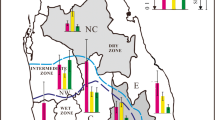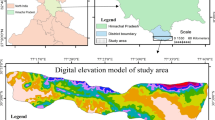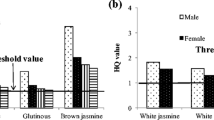Abstract
Lead (Pb), cadmium (Cd), arsenic (As), chromium (Cr), and nickel (Ni) are poisonous, widely distributed, persistent, and transferable to crops, posing potential health risks. This study aims to assess the potential health risks of those elements in rice collected from North-Central Vietnam: Thanh Hoa, Nghe An, and Ha Tinh provinces. Element analysis was performed on rice harvested in November 2020 by ICP-MS. The estimated daily intake (EDI), target hazard quotient (THQ), non-carcinogenic hazard index (HI), and target carcinogenic risk (TR) were used to assess potential health risks for different population groups. The highest element levels (mg kg−1 dry weight) were observed for Cr (0.30 ± 0.11), As (0.17 ± 0.025) and for Pb (0.24 ± 0.013) in Thanh Hoa, and for Cd (0.088 ± 0.015) in Ha Tinh. Strong links were observed between geological formations, mining activities and Cr in rice (Thanh Hoa), or industrial activities and Ni accumulation in rice (Hung Nguyen and Ky Anh districts). Children had greater EDIs than adults, with As having a higher EDI than RfD. Rice THQs indicated a risk trend: Thanh Hoa > Ha Tinh > Nghe An, with As being a significant contributor to HIs. Cr and Cd were significant risk factors and HIs in female children were 1.5 times higher than in other groups. Based on TR values for Ni and Pb, a potential carcinogenic risk to rice eaters was observed, particularly Ni. The data revealed a significant human health risk (both non-carcinogenic and carcinogenic) connected with rice consumption. Therefore, crops and foods from North-Central Vietnam should be strictly regulated.





Similar content being viewed by others
Data availability
The datasets used in this study are available from the corresponding author on reasonable request.
References
Antoine, J. M. R., Fung, L. A. H., & Grant, C. N. (2017). Assessment of the potential health risks associated with the aluminium, arsenic, cadmium and lead content in selected fruits and vegetables grown in Jamaica. Toxicology Reports, 4, 181–187. https://doi.org/10.1016/j.toxrep.2017.03.006
Azam, S. M. G. G., Sarker, T. C., & Naz, S. (2016). Factors affecting the soil arsenic bioavailability accumulation in rice and risk to human health: a review. Toxicology Mechanisms and Methods, 26(8), 565–579. https://doi.org/10.1080/15376516.2016.1230165
Bui, A. T. K., Duong, L. T., & Nguyen, M. N. (2020). Accumulation of copper and cadmium in soil–rice systems in terrace and lowland paddies of the Red river basin, Vietnam: The possible regulatory role of silicon. Environmental Geochemistry and Health, 42(11), 3753–3764. https://doi.org/10.1007/s10653-020-00626-y
Bui, A. T., Nguyen, H. T., Nguyen, M. N., Tran, T. H., Vu, T. V., Nguyen, C. H., & Reynolds, H. L. (2016). Accumulation and potential health risks of cadmium, lead and arsenic in vegetables grown near mining sites in Northern Vietnam. Environmental Monitoring and Assessment, 188(9), 525. https://doi.org/10.1007/s10661-016-5535-5
Chanpiwat, P., Hensawang, S., Suwatvitayakorn, P., & Ponsin, M. (2019). Risk assessment of bioaccessible arsenic and cadmium exposure through rice consumption in local residents of the Mae Tao Sub-district, Northwestern Thailand. Environmental Geochemistry and Health, 41(1), 343−356. https://doi.org/10.1007/s10653-018-0098-8
Chen, Q. Y., DesMarais, T., & Costa, M. (2019). Metals and mechanisms of carcinogenesis. Annual Review of Pharmacology and Toxicology, 59, 537–554. https://doi.org/10.1146/annurev-pharmtox-010818-021031
Chien, L. C., Hung, T. C., Choang, K. Y., Yeh, C. Y., Meng, P. J., Shieh, M. J., & Ha, B. C. (2002). Daily intake of TBT, Cu, Zn, Cd and As for fishermen in Taiwan. Science of the Total Environment, 285(1–3), 177–185. https://doi.org/10.1016/s0048-9697(01)00916-0
Chu, D. B., Duong, H. T., Nguyet-Luu, M. T., Vu-Thi, H.-A., Ly, B.-T., & Loi, V. D. (2021). Arsenic and Trace elements in Vietnamese rice: Assessment of human exposure to these elements through rice consumption. Journal of Analytical Methods in Chemistry, 2021, 6661955. https://doi.org/10.1155/2021/6661955
Codex Alimentarius Commision (CAC), Joint FAO/WHO Food Standards Program, standard for rice, (Amended in 2019; Accessed on 2021, December 24) [https://www.fao.org/fao-who-codexalimentarius/codex-texts/all-standards/en/].
Fan, Y., Zhu, T., Li, M., He, J., & Huang, R. (2017). Heavy metal contamination in soil and brown rice and human health risk assessment near three mining areas in Central China. Journal of Healthcare Engineering, 2017, 4124302–4124302. https://doi.org/10.1155/2017/4124302
FAO, FAOSTAT–Food Balances (2010) (2021, December 24) [https://www.fao.org/faostat/en/#data/FBS].
Guo, B., Hong, C., Tong, W., Xu, M., Huang, C., Yin, H., Lin, Y., & Fu, Q. (2020). Health risk assessment of heavy metal pollution in a soil-rice system: A case study in the Jin-Qu basin of China. Scientific Reports, 10(1), 11490. https://doi.org/10.1038/s41598-020-68295-6
Hang, X., Wang, H., Zhou, J., Ma, C., Du, C., & Chen, X. (2009). Risk assessment of potentially toxic element pollution in soils and rice (Oryza sativa) in a typical area of the Yangtze River delta. Environmental Pollution, 157(8–9), 2542–2549. https://doi.org/10.1016/j.envpol.2009.03.002
Hensawang, S., et al. (2020). Probabilistic assessment of the daily intake of microelements and toxic elements via the consumption of rice with different degrees of polishing. Journal of the Science of Food and Agriculture, 100(10), 4029–4039.
Huang, S. S., Liao, Q. L., Hua, M., Wu, X. M., Bi, K. S., Yan, C. Y., Chen, B., & Zhang, X. Y. (2007). Survey of heavy metal pollution and assessment of agricultural soil in Yangzhong district, Jiangsu province China. Chemosphere, 67(11), 2148–2155. https://doi.org/10.1016/j.chemosphere.2006.12.043
Khoi, N. N. (2014). Mineral resources potential of Vietnam and current state of mining activity. Applied Environmental Research, 36, 37–46.
Kien, C. N., Noi, N. V., Son, L. T., Ngoc, H. M., Tanaka, S., Nishina, T., & Iwasaki, K. (2010). Heavy metal contamination of agricultural soils around a chromite mine in Vietnam. Soil Science and Plant Nutrition, 56(2), 344–356. https://doi.org/10.1111/j.1747-0765.2010.00451.x
Mao, C., Song, Y., Chen, L., Ji, J., Li, J., Yuan, X., Yang, Z., Ayoko, G. A., Frost, R. L., & Theiss, F. (2019). Human health risks of trace elements in paddy rice based on transfer characteristics of trace elements from soil to rice. CATENA, 175, 339–348. https://doi.org/10.1016/j.catena.2018.12.029
National Institute of Nutrition, UNICEF-Viet Nam (Accessed in 2012, December 2021)., A review of the Nutrition situation in Vietnam 2009–2010 [http://viendinhduong.vn/en/nutrition-database/a-review-of-the-nutrition-situation-in-vietnam-2009-2010.html].
Ngo, H. T. T., Tran, L. A. T., Nguyen, D. Q., Nguyen, T. T. H., Le, T. T., & Gao, Y. (2021). Metal pollution and bioaccumulation in the Nhue-Day river basin, Vietnam: Potential ecological and human health risks. International Journal of Environmental Research and Public Health, 18(24), 13425.
Nguyen, H. P. A., Cu, Y. H., Watchalayann, P., & Soonthornchaikul, N. (2021). Assessing inorganic arsenic in rice and its health risk to consumers in Ho Chi Minh City Vietnam. Journal of Health Research, 35(5), 402–414. https://doi.org/10.1108/JHR-09-2019-0221
Nguyen, T. H., Sakakibara, M., Sano, S., & Mai, T. N. (2011). Uptake of metals and metalloids by plants growing in a lead-zinc mine area Northern Vietnam. J Hazard Mater, 186(2–3), 1384–1391. https://doi.org/10.1016/j.jhazmat.2010.12.020
Phan, K., Sthiannopkao, S., Heng, S., Phan, S., Huoy, L., Wong, M. H., & Kim, K. W. (2013). Arsenic contamination in the food chain and its risk assessment of populations residing in the Mekong river basin of Cambodia. Journal of Hazardous Materials, 262, 1064–1071. https://doi.org/10.1016/j.jhazmat.2012.07.005
Qu, M., Li, W., Zhang, C., Huang, B., & Zhao, Y. (2015). Assessing the pollution risk of soil chromium based on loading capacity of paddy soil at a regional scale. Scientific Reports, 5(1), 18451. https://doi.org/10.1038/srep18451
Rodriguez, L., Rincón, J., Asencio, I., & Rodríguez-Castellanos, L. (2007). Capability of selected crop plants for shoot mercury accumulation from polluted soils: Phytoremediation perspectives. International Journal of Phytoremediation, 9(1), 1–13. https://doi.org/10.1080/15226510601139359
Shaheen, N., Ahmed, M. K., Islam, M. S., Habibullah-Al-Mamun, M., Tukun, A. B., Islam, S., & Rahim, A. T. M. A. (2016). Health risk assessment of trace elements via dietary intake of “non-piscine protein source” foodstuffs (meat, milk and egg) in Bangladesh. Environmental Science and Pollution Research, 23(8), 7794–7806. https://doi.org/10.1007/s11356-015-6013-2
Shimbo, S., Zhang, Z. W., Watanabe, T., Nakatsuka, H., Matsuda-Inoguchi, N., Higashikawa, K., & Ikeda, M. (2001). Cadmium and lead contents in rice and other cereal products in Japan in 1998–2000. Science of the Total Environment, 281(1–3), 165–175. https://doi.org/10.1016/s0048-9697(01)00844-0
Sridhara, C. N., Kamala, C. T., Raj, S. S., & D. (2008). Assessing risk of trace elements from consuming food grown on sewage irrigated soils and food chain transfer. Ecotoxicology and Environmental Safety, 69(3), 513–524. https://doi.org/10.1016/j.ecoenv.2007.04.013
Tran, C. T., Le, T. T., Duong, L. T., Dultz, S., & Nguyen, M. N. (2020). A comparative study of arsenic in rice in lowland and terraced paddies in the Red river basin Vietnam. Land Degradation and Development, 31(17), 2635–2647. https://doi.org/10.1002/ldr.3638
Uriu-Adams, J. Y., & Keen, C. L. (2005). Copper, oxidative stress, and human health. Molecular Aspects of Medicine, 26(4–5), 268–298. https://doi.org/10.1016/j.mam.2005.07.015
US EPA, (2014). (2021, December 24). EPA Region 3 risk-based concentration table. [https://cfpub.epa.gov/ncea/iris/search/index.cfm].
US EPA, (released in November 2021, Accessed on December 24, 2021). Regional screening level (RSL) summary table. [https://www.epa.gov/risk/regional-screening-levels-rsls-generic-tables].
Xiao, L., Guan, D., Peart, M. R., Chen, Y., Li, Q., & Dai, J. (2017). The influence of bioavailable trace elements and microbial parameters of soil on the metal accumulation in rice grain. Chemosphere, 185, 868–878. https://doi.org/10.1016/j.chemosphere.2017.07.096
Xu, X. Y., McGrath, S. P., Meharg, A. A., & Zhao, F. J. (2008). Growing rice aerobically markedly decreases arsenic accumulation. Environmental Science and Technology, 42(15), 5574–5579. https://doi.org/10.1021/es800324u
Zarcinas, B. A., Ishak, C. F., McLaughlin, M. J., & Cozens, G. (2004). Trace elements in soils and crops in Southeast Asia 1. Peninsular Malaysia. Environmental Geochemistry Health, 26(4), 343–357. https://doi.org/10.1007/s10653-005-4669-0
Zheng, N., Wang, Q., Zhang, X., Zheng, D., Zhang, Z., & Zhang, S. (2007). Population health risk due to dietary intake of trace elements in the industrial area of Huludao City China. Science Total Environmental, 387(1–3), 96–104. https://doi.org/10.1016/j.scitotenv.2007.07.044
Zhuang, P., McBride, M. B., Xia, H., Li, N., & Li, Z. (2009). Health risk from trace elements via consumption of food crops in the vicinity of Dabaoshan mine, South China. Science of the Total Environment, 407(5), 1551–1561. https://doi.org/10.1016/j.scitotenv.2008.10.061
Zulkafflee, N. S., et al. (2022). Heavy Metal Contamination in Oryza sativa L. at the Eastern region of Malaysia and Its risk assessment. International Journal of Environmental Research and Public Health, 19(2), 739. https://doi.org/10.3390/ijerph19020739
Acknowledgements
This research is partly funded by Internship Program for Ms. Nguyen Quynh from International Environmental Research Institute (IERI) at Gwangju Institute of Science and Technology (GIST) in spring 2020. We'd also like to thank our students, Phong and Tung, for assisting us with the rice sample collection and processing. We are grateful to Ms. Nguyen Quynh Anh from Vietnam Institute of Geosciences and Mineral Resources and Ms. Eunkyung Cho from Gwangju Institute of Science and Technology for their contributions in measuring trace elements from rice samples.
Author information
Authors and Affiliations
Contributions
TLT: Investigation, Methodology, Writing original draft—Review and Editing. KKW.: Resource, Validation. DNQ: Validation, Conceptualization. HNTT: Conceptualization, Methodology, Writing—Review and Editing, Supervision. All authors have read and agreed to the published version of the manuscript.
Corresponding author
Ethics declarations
Conflict of interest
The authors declare no conflict of interest.
Ethical approval
This article does not contain any studies with human participants or animals performed by any of the authors.
Additional information
Publisher's Note
Springer Nature remains neutral with regard to jurisdictional claims in published maps and institutional affiliations.
Supplementary Information
Below is the link to the electronic supplementary material.
Rights and permissions
Springer Nature or its licensor (e.g. a society or other partner) holds exclusive rights to this article under a publishing agreement with the author(s) or other rightsholder(s); author self-archiving of the accepted manuscript version of this article is solely governed by the terms of such publishing agreement and applicable law.
About this article
Cite this article
Le, T.T., Kim, KW., Nguyen, D.Q. et al. Trace element contamination in rice and its potential health risks to consumers in North-Central Vietnam. Environ Geochem Health 45, 3361–3375 (2023). https://doi.org/10.1007/s10653-022-01415-5
Received:
Accepted:
Published:
Issue Date:
DOI: https://doi.org/10.1007/s10653-022-01415-5




